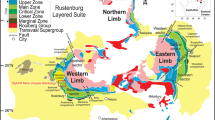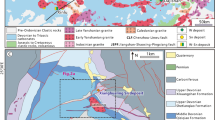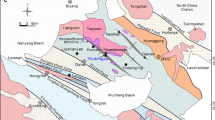Abstract
REE patterns of hydrothermally altered rocks, fluid inclusions, and stable oxygen isotopes of quartz were studied at the Natalka gold deposit. Metasomatic rocks formed under decompression reveal gradual depletion in LREE and HREE relative to siltstone of the protolith. The HREE patterns of metasomatic rocks formed under decompression are uniform; an insignificant removal of LREE can be noted. The progressive extraction of REE with increasing alteration of rocks could have been due to the effect of magmatogenic or meteoric fluid. Because a Ce anomaly is absent, the participation of oxidized meteoric water was limited. The inverse correlation between the total REE content and the Eu anomaly value in altered rocks indicates a substantial role of magmatogenic fluid. The REE patterns of altered rocks formed under compression show that the role of metamorphic fluid was not great. All metasomatic rocks are enriched in LREE, so that the enrichment of fluid in LREE as well may be suggested. Three fluid compositions were captured as fluid inclusions: (1) H2O-CO2-NaCl-MgCl2 with a salinity of 1.0–4.9 wt % NaCl equiv, (2) CO2-CH4, and (3) H2O-NaCl-MgCl2 with a salinity of 7.0–5.6 wt % NaCl equiv. Compositions (1) and (2) coexisted in the mineral-forming system at 250–350°C and 1.1–2.4 kbar as products of phase separation under conditions of decreasing P and T. The interaction of this fluid with host rocks resulted in the formation of extensive halos of beresitized rocks with sulfide disseminations. The precipitation of arsenopyrite and pyrite led to the substantial depletion of mineral-forming fluid in H2S and destabilization of the Au(HS)2− complex. The fluid with the third composition arose due to the boiling of the H2O-CO2-CH4-NaCl-MgCl2 liquid and was responsible for metasomatic alteration of host rocks. The late mineral assemblages were deposited from this fluid at the initial stage of ore formation. The high methane concentrations in the ore-forming fluid were likely caused by interaction of hydrothermal ore-bearing solutions with carbonaceous host rocks. The δ18O values of quartz from quartz-scheelite-pyrite-arsenopyrite and sulfide-sulfosalt mineral assemblages vary from +11.6 to +14.1‰ and +11.2 to +13.5‰, respectively. The parental fluids of the early and late mineral assemblages probably were derived from a magmatic source and were characterized by \( \delta ^{18} O_{H_2 O} \) = +6.3 to +8.8‰ at 350°C and +3.6 to +5.9‰ at 280°C, respectively. The narrow interval of oxygen isotopic compositions shows that this source was homogeneous. The data obtained allow us to suggest that the deposit formation was related to magmatic activity, including the direct supply of ore components from a magma chamber and mobilization of these components in the processes of dehydration and decarbonation during contact and regional metamorphism.
Similar content being viewed by others
References
Yu. A. Balashov, Geochemistry of Rare Earth Elements (Nauka, Moscow, 1976) [in Russian].
M. Bau and P. Möller, “Rare Earth Elements Fractionation in Metamorphogenic Hydrothermal Calcite, Magnesite and Siderite,” Mineral. Petrol. 45, 231–246 (1992).
F. P. Bierlein and S. Maher, “Orogenic Disseminated Gold in Phanerozoic Fold Belts: Examples from Victoria, Australia and Elsewhere,” Ore Geol. Rev. 17, 215–232 (2001).
R. J. Bodnar and M. O. Vityk, “Interpretation of Microthermometric Data for H2O-NaCl Fluid Inclusions,” in Fluid Inclusions in Minerals: Methods and Applications (Siena, Pontignano, 1994), pp. 117–130.
A. S. Borisenko, “Study of Salt Composition of Fluid Inclusions in Minerals with Cryometric Method,” Geol. Geofiz. 18(8), 16–27 (1977).
N. S. Bortnikov, “Mineralogy, Geochemistry and Origin of the Black Shale Hosted Gold Deposits of the Former Soviet Union,” in Mineral Deposits: from Their Origin to Their Environmental Impacts (Prague, 1995), pp. 935–937.
N. S. Bortnikov, “Geochemistry and Genesis of the Ore-Forming Fluids in Hydrothermal-Magmatic Systems in Tectonically Active Zones,” Geol. Rudn. Mestorozhd. 48(1), 3–28 (2006) [Geol. Ore Deposits 48 (1), 1–22 (2006)].
N. S. Bortnikov and V. Y. Prokof’ev, “World-Class Mesothermal Gold Deposits of Russia: Composition and Origin of Ore-Forming Fluids,” in Proceedings of the 9th Biennial SGA Meeting on Mineral Exploration and Research: Digging Deeper (Dublin, 2007), Vol. 1, pp. 793–796.
N. S. Bortnikov, G. N. Gamyanin, O. V. Vikent’eva, et al., “Fluid Composition and Origin in the Hydrothermal System of the Nezhdaninsky Gold Deposit, Sakha (Yakutia), Russia,” Geol. Rudn. Mestorozhd. 49(2), 99–145 (2007) [Geol. Ore Deposits 49 (2), 87–128 (2007)].
N. S. Bortnikov, G. N. Gamyanin, V. B. Naumov, and L. P. Nosik, “The Nezhdaninskoye Mesothermal Gold Deposit, Russia: Ore-Forming Fluid and Deposition Environment,” in Current Research in Geology Applied to Ore Deposits (Univ. Granada, Granada, 1993), pp. 419–422.
N. S. Bortnikov, G. N. Gamyanin, V. V. Alpatov, et al., “Mineralogy, Geochemistry, and Origin of the Nezhdaninsky Gold Deposit (Sakha-Yakutia, Russia),” Geol. Rudn. Mestorozhd. 40(2), 137–156 (1998) [Geol. Ore Deposits 40 (2), 121–138 (1998)].
N. S. Bortnikov, I. A. Bryzgalov, N. N. Krivitskaya, et al., “The Maisky Multistage Stringer-Disseminated Gold-Sulfide Deposit (Chukotka, Russia): Mineralogy, Fluid Inclusions, Stable Isotopes (O and S), History, and Formation Conditions,” Geol. Rudn. Mestorozhd. 46(6), 475–509 (2004) [Geol. Ore Deposits 46 (6), 409–440 (2004)].
N. S. Bortnikov, V. N. Sazonov, I. V. Vikentyev, et al., “The Berezovsky Giant Gold Quartz Deposit, Urals, Russia: Fluid Inclusion and Stable Isotope Studies,” in Mineral Deposits: Research and Exploration-Where Do They Meet? (Balkema, Rotterdam, 1997), pp. 157–160.
N. S. Bortnikov, V. Yu. Prokof’ev, and N. V. Razdolina, “Origin of the Charmitan Gold-Quartz Deposit (Uzbekistan),” Geol. Rudn. Mestorozhd. 38(3), 238–257 (1996) [Geol. Ore Deposits 38 (3), 208–226 (1996)].
P. Brown, “FLINCOR: a Computer Program for the Reduction and Investigation of Fluid Inclusion Data,” Am. Mineral. 74, 1390–1393 (1989).
V. A. Buryak, I. S. Nemenman, N. V. Berdnikov, et al., “Fluid Regime of Formation and Source of Ore-Forming Solutions of Gold-Quartz Lodes in the Allakh-Yun Zone,” Tikhookean. Geol. 9(3), 62–70 (1990).
G. M. Claypool and J. R. Kaplan, “The Origin and Distribution of Methane in Marine Sediments,” in Natural Gases in Marine Sediments (Plenum Press, New York, 1974), Vol. 3, p. 132.
P. L. P. Collins, “Gas Hydrates in CO2-Bearing Fluid Inclusions and the Use of Freezing Data for Estimation of Salinity,” Econ. Geol. 74, 1435–1444 (1979).
R. S. Darling, “An Extended Equation to Calculate NaCl Contents from Final Clathrate Melting Temperatures in H2O-CO2-NaCl Fluid Inclusions: Implications for P-T-Isochors Location,” Geochim. Cosmochim. Acta 55, 3869–3871 (1991).
S. E. Drummond and H. Ohmoto, “Chemical Evolution and Mineral Deposition in Boiling Hydrothermal Systems,” Econ. Geol. 89, 126–147 (1985).
R. A. Eremin, S. V. Voroshin, V. A. Sidorov, et al., “Geology and Genesis of the Natalka Gold Deposit, Northeast Russia,” Int. Geol. Review 36, 1113–1138 (1994).
L. V. Firsov, “Age of Spessarite-Vogesite with Quartz Fragments at the Natalka Deposit,” Kolyma, No. 10, 34–37 (1964).
L. V. Firsov, “K-Ar Dating of Pre-and Postmineral Dikes in the Yana-Kolyma Gold Belt,” Izv. Akad. Nauk SSSR, Ser. Geol., No. 11, 204–210 (1967).
G. N. Gamyanin, N. S. Bortnikov, and V. V. Alpatov, The Nezhdaninsky Gold Deposit: An Unique Deposit of Northeastern Russia (Geos, Moscow, 2000) [in Russian].
Geodynamics, Magmatism, and Metallogeny of the Russian Far East (Dal’nauka, Vladivostok, 2006) [in Russian].
M. Ghaderi, M. Palin, I. H. Campbell, and P. J. Sylvester, “Rare Earth Element Systematics in Scheelite from Hydrothermal Gold Deposits in the Kalgoorlie-Norseman Region, Western Australia,” Econ. Geol. 94, 423–438 (1999).
R. J. Goldfarb, N. Baker, and B. Dube, “Distribution, Character and Genesis of Gold Deposits in Metamorphic Terranes,” Econ. Geol. 100, 407–409 (2005).
R. J. Goldfarb, D. L. Leach, S. C. Rose, and G. P. Landis, “Fluid Inclusion Geochemistry of Gold-Bearing Quartz Veins of the Juneau Gold Belt, Southeastern Alaska: Implications for Ore Genesis,” Econ. Geol. Monograph 6, 363–375 (1989).
R. J. Goldfarb, R. J. Newberry, W. J. Pickthhorn, and C. L. Gent, “Oxygen, Hydrogen and Sulfur Isotope Studies in the Juneau Gold Belt, Southeastern Alaska: Constraints on the Origin of Hydrothermal Fluids,” Econ. Geol. 86, 66–80 (1991).
V. V. Golub and N. A. Goryachev, “Role of Transverse Faults in Localization of Gold Mineralization of the Natalka Deposit,” in Proceedings of All-Russian Conference: Science of Northeastern Russia—the Onset of Century (SVKNII, Magadan, 2005), pp. 158–160 [in Russian].
V. V. Golub and N. A. Goryachev, Mineralogical and Geochemical Features of Ore Zones and Ore Shoots at Deep Levels of the Natalka Deposit (Yakutian Sci. Center, Siberian Branch, Russian Acad. Sci., Yakutsk, 2006) [in Russian].
S. Yu. Golubev, “Morphology of Orebodies at the Natalka Gold-Quartz Large-Tonnage Deposit,” in Proceedings of Scientific and Practical Conference on Forecasting, Exploration, and Evaluation of Metallic and Nonmetallic Deposits: Advances and Outlook (TsNIGRI, Moscow, 2008), p. 58.
V. I. Goncharov, S. V. Voroshin, and V. A. Sidorov, The Natalka Gold Deposit (Severovost. Nauchn. Tsentr Dalnevost. Otd. Ross. Akad. Nauk, Magadan, 2002) [in Russian].
N. A. Goryachev, Veined Quartz of Gold Deposits in the Yano-Kolyma Belt (SVKNII, Magadan, 1992) [in Russian].
N. A. Goryachev, Genesis of Gold-Quartz Vein Belts of the North Pacific (SVKNII, Magadan, 2003) [in Russian].
N. A. Goryachev, V. A. Sidorov, I. S. Litvinenko, and T. I. Mikhalitsyna, “Mineral Composition, Petrographic, and Geochemical Features of Ore Zones at Deep Levels of the Natalka Deposit,” Kolyma, No. 2, 38–49 (2000).
S. A. Grigorov, “Genesis and Formation Dynamics of the Natalka Gold Deposit As Deduced from Systematic Analysis of Geochemical Field,” Rudy Met., No. 3, 44–48 (2006).
D. I. Groves, R. J. Goldfarb, F. Robert, and C. J. R. Hart, “Gold Deposits in Metamorphic Belts: Overview of Current Understanding, Outstanding Problems, Future Research, and Exploration Significance,” Econ. Geol. 98, 1–29 (2003).
L. A. Haskin, M. A. Haskin, F. A. Frey, and T. R. Wildman, “Relative and Absolute Terrestrial Abundances of the Rare Earths,” in Origin and Distribution of the Elements (Pergamon, New York, 1968), pp. 889–912.
J. W. Hedenquist and R. W. Henley, “The importance of CO2 on Freezing Point Measurements of Fluid Inclusions: Evidence from Active Geothermal Systems and Implications for Epithermal Ore Deposition,” Econ. Geol. 80, 1379–1406 (1985).
C. J. Hodgson, D. A. Love, and J. V. Hamilton, “Giant Mesothermal Gold Deposits: Descriptive Characteristics, Genetic Model and Exploration Are Selection Criteria,” in Giant Ore Deposits. SEG SP-2 (1993), pp. 157–206.
W. Irber, “The Lanthanide Tetrad Effect and Its Correlation with K/Rb, Eu/Eu*, Sr/Eu, Y/Ho, and Zr/Hf of Evolving Peraluminous Granite Suites,” Geochim. Cosmochim. Acta 63(3/4), 489–508 (1999).
S.-Y. Jiang, J.-M. Yu, and J.-J. Lu, “Trace and Rare-Earth Element Geochemistry in Tourmaline and Cassiterite from the Yunlong Tin Deposit, Yunnan, China: Implication for Magmatitic-Hydrothermal Fluid Evolution and Ore Genesis,” Chem. Geol. 209, 193–213 (2004).
A. I. Kalinin, Multifactor Forecasting and Exploration Models of Gold and Silver Deposits in Northeastern Russia (Nedra, Moscow, 1992) [in Russian].
A. I. Kalinin, V. K. Kanishchev, A. G. Orlov, and V. V. Gashtol’d, “Structure of the Natalka Ore Field,” Kolyma, No. 10/11, 10–14 (1992).
V. A. Kalyuzhny, Principles of the Science on Mineral-Forming Fluids (Naukova Dumka, Kiev, 1982) [in Russian].
R. Kerrich, “Mesothermal Gold Deposits: A Critique of Genetic Hypotheses,” in Greenstone Gold and Crustal Evolution (Geol. Assoc. Canada, 1990), pp. 13–31.
R. Kerrich, R. J. Goldfarb, D. I. Groves, and S. Garwin, “The Geodynamics of World-Class Gold Deposits: Characteristics, Space-Time Distribution and Origins,” Rev. Econ. Geol. 13, 501–551 (2000).
I. M. Khasanov, V. G. Ermolenko, and V. G. Shakhtyrov, “Deep Structure of the Omchak Ore Cluster,” in Problems of Geology and Metallogeny of Northeastern Asia at the Turn of Millenniums (SVKNII, Magadan, 2001), Vol. 1, pp. 286–289 [in Russian].
M. M. Konstantinov, E. M. Nekrasov, A. A. Sidorov, and S. F. Struzhkov, Gold Giants of Russia and the World (Nauchnyi Mir, Moscow, 2000) [in Russian].
O. P. Kreuzer, “Intrusion-Hosted Mineralization in the Charters Towers Goldfield, North Queensland: New Isotopic and Fluid Inclusion Constraints on the Timing and Origin of the Auriferous Veins,” Econ. Geol. 100, 1583–1603 (2005).
N. K. Kurbanov, Ch. Kh. Arifulov, P. G. Kucherevsky, et al., “Geological and Genetic Models of the Gold Deposits in Carbonaceous Terrigenous Complexes,” Rudy Met., No. 2, 55–69 (1994).
V. G. Lashkov, E. L. Bel’chenko, and B. V. Guzman, Gold of Russia’s Subsurface (EKOS, Moscow, 2000) [in Russian].
B. G. Lottermoser, “Rare Earth Elements and Hydrothermal Ore Formation Processes,” Ore Geol. Rev. 7, 25–41 (1992).
Y. Matsuhisa, J. R. Goldsmith, and R. N. Clayton, “Oxygen Isotopic Fractionation in the System Quartz-Albite-Anorthite-Water,” Geochim. Cosmochim. Acta 43, 1131–1140 (1979).
Metasomatism and Metasomatic Rocks (Nauchnyi Mir, Moscow, 1998) [in Russian].
S. V. Mezhov, “Geological Structure of the Natalka Gold Deposit,” Kolymskie Vesti, No. 9, 8–17 (2000).
S. V. Mezhov and I. M. Khasanov, “Deep Structure of the Southwestern Limb of the Ayan-Yuryakh Anticlinorium,” in Geology and Metallogeny of the Northeastern Asia at the Turn of Milleniums (SVKNII, Magadan, 2001), Vol. 1, pp. 263–266 [in Russian].
R. M. Mirgorodskaya, E. A. Zimenko, N. A. Goryachev, et al., “Molybdenum Porphyry Mineralization of the Omchak Ore Cluster,” in Geology, Geography, and Biological. Diversity of Northeastern Russia (SVKNII, Magadan, 2006), pp. 162–163 [in Russian].
B. E. Nesbitt, “Phanerozoic Gold Deposits in Tectonically Active Continental Margins,” in Gold Metallogeny and Exploration (Blackie and Son, Glasgow, 1991), pp. 104–132.
B. E. Nesbitt and K. Muchlenbachs, “Geology, Geochemistry, and Genesis of Mesothermal Lode Gold Deposits of the Canadian Cordillera: Evidence for Ore Formation from Evolved Meteoric Water,” Econ. Geol. Monograph 6, 553–563 (1989).
R. J. Newberry, P. W. Layer, P. B. Hans, et al., “Prelimenery Analysis of Chronology of Mesozoic Magmatism, Tectonics, and Ore Mineralization in Northeastern Russia: 40Ar/39Ar Dating and Trace Elements of Igneous and Ore-Bearing Rocks,” in Gold Mineralization and Granitoid Magmatism of the Northern Pacific: Vol. 1., Geology, Geochronology, and Geochemistry (SVKNII, Magadan, 2000), pp. 181–205 [in Russian].
V. A. Pristavko, V. A. Sidorov, T. I. Mikhalitsina, et al., “Geological and Geochemical Model of the Natalka Gold Deposit,” Kolymskie Vesti, No. 9, 18–24 (2000).
J. R. Ridley and L. W. Diamond, “Fluid Chemistry of Orogenic Lode Gold Deposits and Implication for Genetic Models. Gold in 2000,” Rev. Econ. Geol 13, 141–162 (2000).
E. Roedder, Fluid Inclusions in Minerals (Reviews in Mineralogy, Mineral. Soc. Amer., 1984, Vol. 12; Mir, Moscow, 1987).
V. N. Sazonov, O. V. Vikent’eva, V. N. Ogorodnikov, et al., “REE in Columns of Propylitization, Albitization, Aceitization, and Beresitization-Listvenitization of Rocks with Various Silica Content: Evolution of Distribution, Causes, and Practical Implications,” Litosfera, No. 3, 108–124 (2006).
V. M. Sharafutdinov and I. M. Khasanov, “Petrophysical Zoning of the Natalka Gold Deposit,” Vestn. Severovost. Nauchn. Tsentr, Dal’nevost. Otd. Ross. Akad. Nauk, No. 4, 2–11 (2006).
A. A. Sidorov and I. N. Tomson, “Ore Potential of Black Shale Sequences: Convergence of Alternative Concepts,” Vestn. Ross. Akad. Nauk 70(8), 719–724 (2000).
A. A. Sidorov, N. A. Goryachev, N. E. Savva, et al., Essays on Metallogeny and Geology of Ore Deposits in Northeastern Russia (Severovost. Nauchn. Tsentr, Dal’nevost. Otd. Ross. Akad. Nauk, Magadan, 1994) [in Russian].
V. A. Sidorov, N. A. Goryachev, and E. A. Zimenko, “The Cretaceous Volcanic Vent of the Vanin Stock (Omchak Ore Cluster): An Unique Geological Monument,” in Geodynamics, Magmatism, and Minerageny of the North Pacific Continental Margins (SVKNII, Magadan, 2003), Vol. 2, pp. 149–153 [in Russian].
V. A. Stepanov, Zoning of Gold-Quartz Mineralization in the Central Kolyma (Magadan oblast, Russia) (Dal’nauka, Vladivostok, 2001), pp. 42–51 [in Russian].
S. F. Struzhkov, M. V. Natalenko, V. B. Chekvaidze, et al., “A Multifactor Model of the Natalka Gold Deposit,” Rudy Met., No. 3, 34–44 (2006).
R. T. Taylor and B. J. Fryer, “Rare Earth Element Chemistry As an Aid to Interpretating Hydrothermal Ore Deposits,” in Metallization Associated with Acid Magmatism (Wiley, New York, 1982), Vol. 6, pp. 357–365.
R. Thiery, A. M. Kerkhof, and J. Dubessy, “VX Properties of CH4-CO2 and CO2-N2 Fluid Inclusions: Modeling for T < 31°C and P < 400 Bars,” Eur. J. Mineral. 6, 753–771 (1994).
E. E. Tyukova and S. V. Voroshin, Composition and Parageneses of Arsenopyrite in Deposits and Host Rocks of the Upper Kolyma Region (to Interpretation of Genesis of Sulfide Asssemblages) (Severovost. Nauchn. Tsentr Dalnevost. Otd. Ross. Akad. Nauk, Magadan, 2007) [in Russian].
E. E. Tyukova, T. I. Mikhalitsyna, and O. V. Vikent’eva, “Rare Earth Mineralization of the Natalka Gold Deposit (Magadan oblast),” in Geochemistry and Ore Formation of Radioactive, Noble, and Rare Metals in Endogenic and Exogenic Processes (Ulan-Ude, 2007), pp. 168–171.
O. V. Vikent’eva, “REE in Metasomatic Rocks of Mesothermal Gold Deposits,” in Proceedings of Annual Session of Russian Mineralogical Society Dedicated to the 110th Anniversary of Academician A.G. Betekhtin (1897–2007) on Role of Mineralogy in Knowledge of Ore Formation (IGEM RAS, Moscow, 2007), pp. 76–80.
S. F. Vinokurov, “Geochemical Significance of Europium Anomalies in the Minerals of Ore Deposits,” Geochem. Int. 32(12), 113–140 (1995).
S. V. Voroshin, V. G. Shakhtyrov, and E. E. Tyukova, “Geology and Genesis of the Natalka Gold Deposit,” Kolyma, No. 2, 22–31 (2000).
Author information
Authors and Affiliations
Corresponding author
Additional information
Original Russian Text © N.A. Goryachev, O.V. Vikent’eva, N.S. Bortnikov, V.Yu. Prokof’ev, V.A. Alpatov, V.V. Golub, 2008, published in Geologiya Rudnykh Mestorozhdenii, 2008, Vol. 50, No. 5, pp. 414–444.
Rights and permissions
About this article
Cite this article
Goryachev, N.A., Vikent’eva, O.V., Bortnikov, N.S. et al. The world-class Natalka gold deposit, northeast Russia: REE patterns, fluid inclusions, stable oxygen isotopes, and formation conditions of ore. Geol. Ore Deposits 50, 362–390 (2008). https://doi.org/10.1134/S1075701508050024
Received:
Published:
Issue Date:
DOI: https://doi.org/10.1134/S1075701508050024




